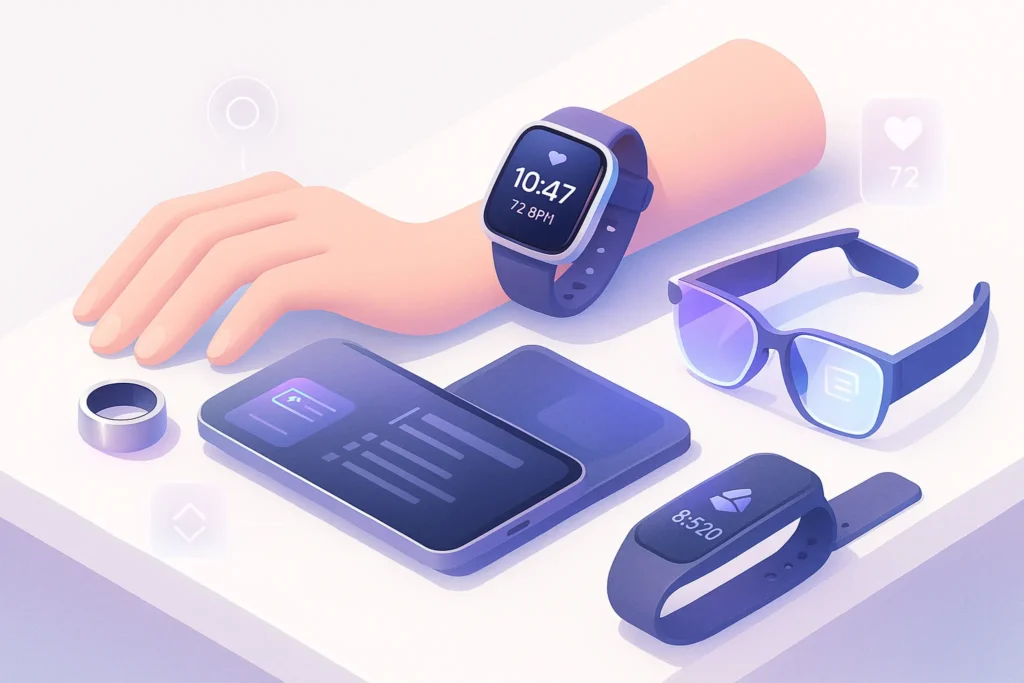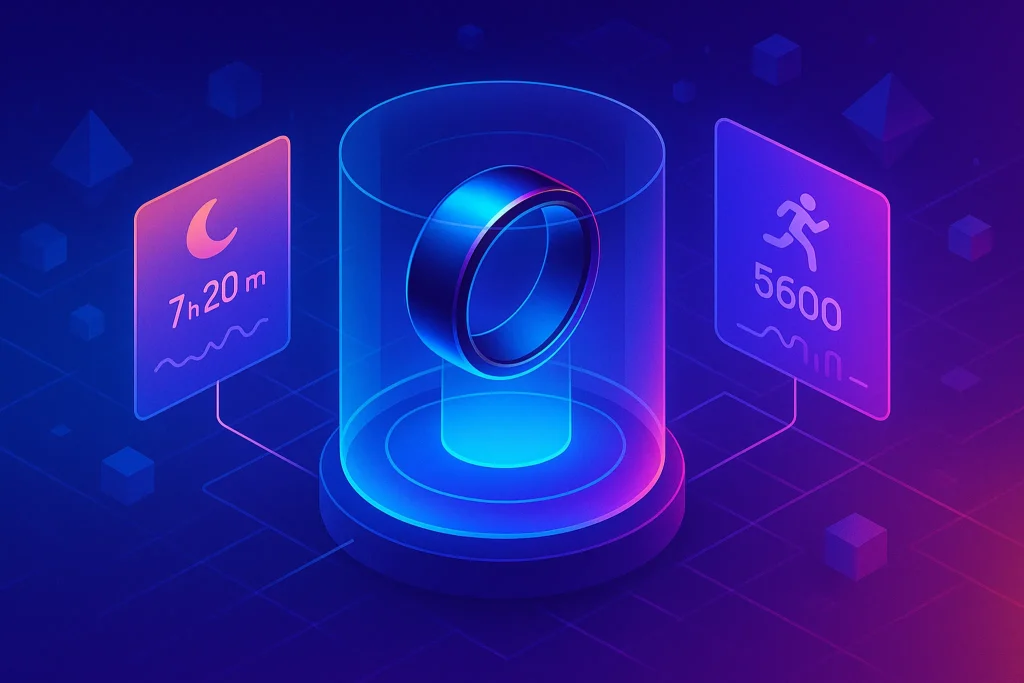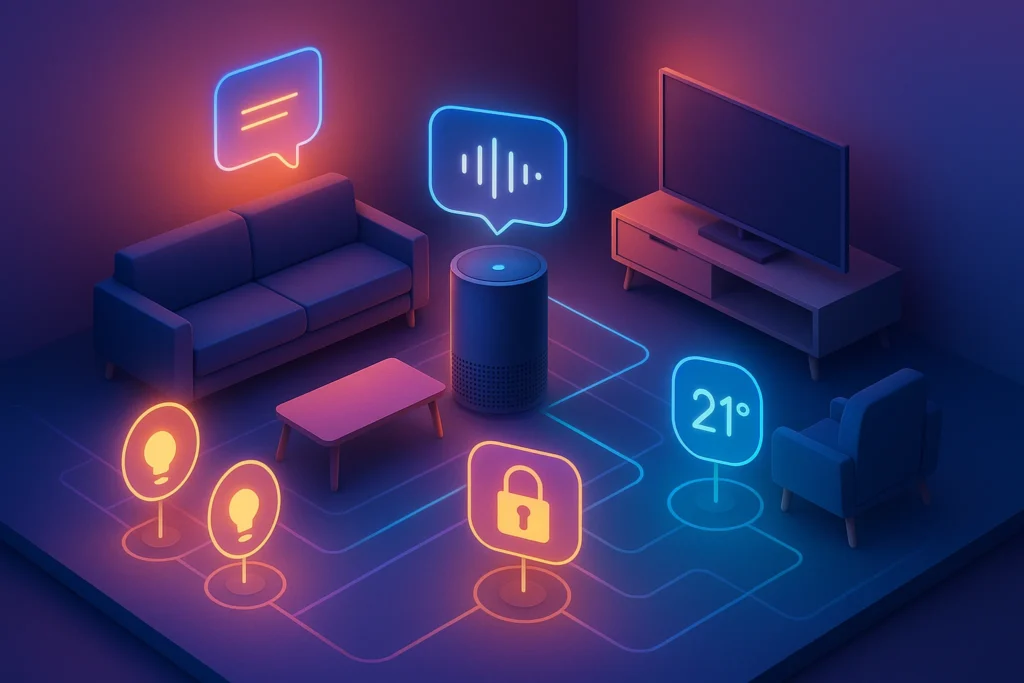-This post may contain affiliate links. If you click on one and make a purchase, I may earn a small commission at no extra cost to you.-
🔍 Introduction
In 2025, wearable tech is more diverse and purposeful than ever—from health-tracking rings to AI-powered glasses. But amidst the excitement, which devices truly enhance daily life and which are just flashy status symbols? This guide separates substance from style by focusing on real-world utility, user experiences, and the contextual benefits of each gadget.
Wearable tech has exploded in 2025. We’ve gone from step counters to wrist-based AI assistants, fitness bands that predict illness, and AR glasses that overlay your calendar in midair. But in a sea of innovation, how many of these gadgets actually make life better—and which are just shiny distractions?
This guide breaks down the latest and most promising categories in wearables: smartwatches, fitness trackers, smart rings, AR glasses, and more. We’ve tested what’s new and filtered the fluff, so you can decide which gadgets actually deserve to be on your wrist—or in your glasses case.
💍 1. Smart Rings: The Minimalist’s Power Tool
In 2025, smart rings are no longer just step counters in disguise. These sleek, discreet wearables pack serious health tracking and daily utility—without screaming “tech.” They’ve become the go-to for users who want function without fuss.
Smart rings are booming, offering discreet wear, biometric precision, and haptic notifications—without being bulky.
Use-Case:
Profile: Creative freelancer avoiding screen burnout
Sara, a 29-year-old designer, wears an Oura Ring Gen 4 to monitor sleep quality and readiness. The ring subtly detects if she’s entering burnout mode based on HRV and temperature shifts. When she pulls all-nighters, the ring recommends lighter cognitive load for the next day. It syncs with her calendar app and reschedules heavy-focus tasks. With no screen, no buzz, and no guilt, it’s like a silent coach wrapped around her finger.
Dana, a busy PR manager, uses the Galaxy Ring to monitor HRV and sleep in a compact form she doesn’t notice. The silent haptic alerts during work help her pause and take mindful breaths.
First-Person Insight:
I wearing one last month; I was surprised how often I forgot I had equipment on—yet it recorded every run, every sleep cycle—without a screen pinging for attention.
💡 Nerd Tip: Looking for deeper comparisons? Our Smart Rings Comparison post breaks down features and price points in detail.
🧠 Top Picks in 2025:
-
Oura Ring Gen 4 – Offers accurate sleep, recovery, and temperature data with a lighter profile and improved battery.
-
Ultrahuman Ring Air – Built for metabolic health and real-time energy tracking with wearable-friendly AI suggestions.
-
Evie Ring – Designed for women, with period cycle tracking and mood pattern analysis.
🤔 Why It’s Worth It:
-
Battery life of 5–7 days
-
No screen = less distraction
-
Great for people who don’t like wearing big devices
-
Surprisingly detailed sleep and recovery tracking
Micro-Comparison:
Oura Ring vs Apple Watch 10
For sleep and long-term recovery metrics, the Oura Ring wins hands down. But the Apple Watch beats it in active alerts and interactivity. Want health + focus? Go Oura. Want interaction + apps? Stick with a watch.
Compared to the Oura Ring (which lacks silent haptics), Galaxy Ring’s advanced sensors and mild vibrations give a balanced blend of insight and presence—unlike smartwatches that demand attention.
🤖 2. AR Glasses (Apple Vision Pro, Meta Ray‑Ban, Nreal)
AR glasses have shifted from sci-fi hype to functional tools—though they’re still early-stage for most consumers. In 2025, the focus is on notifications, real-time translation, and light heads-up displays, not full VR replacement.
AR glasses are shaping up from weekend novelties to productivity tools.
Use-Case:
Profile: Remote content strategist & traveler
Nina, who travels frequently for work, uses XREAL Air 2 glasses to review client docs mid-flight without pulling out a laptop. She watches training videos in augmented space on hotel beds, and answers messages hands-free while walking in a new city. For her, it’s like having a 120″ screen floating in front of her eyes—without needing to carry extra gear.
I wore Apple Vision Pro during virtual workshops across time zones. Floating screens let me reference notes without switching tabs. Passive tasks felt immersive, even sitting on my couch.
First-Person Insight:
Hiding virtual workspace in living rooms still feels like sci‑fi—but in 2025, these glasses actually hit real-world use, not just demo fun.
💡 Nerd Tip: For more on accessible AR now, see our Top Futuristic Gadgets You Can Own Now post.
🧠 Top Picks in 2025:
-
Meta Ray-Ban Smart Glasses (Gen 3) – Subtle design, camera, live streaming, open-ear audio
-
XREAL Air 2 – Personal spatial display for watching movies, browsing, and gaming
-
TCL NXTWEAR S+ – Affordable entry into AR entertainment
🤔 Why It’s (Sometimes) Worth It:
-
Immersive screen replacement
-
Useful for private media consumption, light productivity
-
Great for travelers or frequent flyers
-
Not yet ready for hardcore daily productivity—but getting close
💡 Nerd Tip: You’ll love our picks in Top Futuristic Gadgets You Can Own Now if this kind of tech excites you.
Micro-Comparison:
Meta Ray‑Ban is closer to sunglasses with quick info-flashes. For productivity, Vision Pro wins—but for daily light info and strolling, Ray‑Ban is more stylish and wearable.
⌚ 3. Smartwatches (Apple Watch Series 9, Samsung Galaxy Watch 7)
Smartwatches continue to evolve from passive accessories into active lifestyle assistants. In 2025, the best models offer real-time health data, call/text control, stress tracking, and even AI-powered coaching.
2025’s smartwatches emphasize health more than ever.
Use-Case (Health-Conscious):
Profile: Remote worker with early hypertension
John is 35, works from home, and spends long hours at his desk. He uses the Apple Watch 10 to track blood pressure trends, set micro-stand goals, and monitor his sleep quality. When the watch detected erratic heart rate during a week of heavy stress, it nudged him to take breaks—and ultimately pushed him to see a doctor early. It’s not just a watch; it’s his passive wellness companion.
Javier, a marathon runner, tracks VO₂ max, recovery rate, and blood oxygen. Weighted against Apple Watch’s ECG and fall detection, it becomes an essential part of his training.
First-Person Insight:
My Apple Watch nudged me into a recovery day after detecting elevated heart rate and reduced HRV for two nights—no app required, just proactive insight.
🧠 Top Picks in 2025:
-
Apple Watch Series 10 – With a thinner profile, improved battery, and AI-powered Siri, it’s a full-on digital health coach.
-
Samsung Galaxy Watch Ultra – Rugged design + precise body metrics make it ideal for outdoorsy types.
-
Withings ScanWatch 2 – A hybrid model focused on health-first features with medical-grade sensors.
🤔 Why It’s Worth It:
-
Immediate health insights (like ECG, blood oxygen, sleep stages)
-
Hands-free communication—reply to messages, take calls
-
App integration—syncs with productivity tools, workout apps, meditation sessions
-
Battery improvements—some models now last 3–7 days
Micro-Comparison:
Apple Watch 10 vs Samsung Galaxy Watch Ultra
Apple excels in ecosystem sync and app smoothness. Samsung, however, wins on battery life and extreme-sport readiness. If you’re in the Apple ecosystem, stick with Series 10. Android user? Galaxy Watch Ultra is a beast.
Compared to fitness bands, these watches offer mapping, extended battery life, and medical-grade alerts—not just step counting.
🏃 4. Fitness Bands & Hybrid Watches (Fitbit, Withings, Amazfit)
Fitness trackers in 2025 have leveled up. They now provide cardio readiness, blood oxygen, stress alerts, cycle tracking, and even illness prediction. And they’re much slimmer and better-looking than before.
These hybrids focus on health metrics and long battery.
Use-Case (Budget Athlete):
Profile: Fitness-conscious parent balancing work and workouts
David, 42, uses a Fitbit Charge 7 to manage morning workouts, work stress, and sleep cycles—all while chasing two toddlers. The tracker not only gives him a readiness score each morning but also alerts him when his resting heart rate shows signs of burnout. Based on that, he skips intense cardio and swaps in recovery yoga—keeping him in balance, not just in motion.
Mira, a weekend cyclist, uses an Amazfit band to log rides and stress—hardware that lasts 2 weeks without charge.
First-Person Insight:
Putting the band on felt care-free; no worry about nightly charging—but still shows detailed heart-rate zones and sleep metrics.
🧠 Top Picks in 2025:
-
Fitbit Charge 7 – Lightweight and loaded with full-day health insights
-
Xiaomi Smart Band 9 Pro – Budget-friendly with surprising depth in features
-
Whoop 5.0 – Subscription-based tracker that focuses on strain, recovery, and elite-level performance metrics
🤔 Why It’s Worth It:
-
Excellent battery life (up to 10 days)
-
Works well even without a smartphone nearby
-
Often cheaper than smartwatches
-
Motivational for beginners and intermediate users
Micro-Comparison:
Better than older Fitbits in sleep stage detection; lacks mapping from watches, but excels in affordability and wearability.
Fitbit Charge 7 vs Whoop 5.0
Fitbit is better for casual users and budget-conscious folks who want simplicity and value. Whoop, on the other hand, is for data-hungry athletes willing to pay a monthly fee for deeper coaching.
🧠 5. Niche Wearables (Posture Sensors, Sleep Bands)
Specialized tech like Upright posture trackers and Muse 2 EEG bands target focused issues.
Use-Case (Desk Worker):
Laura uses a smart posture clip that gently vibrates when slumping. After a week, her back pain eased and she sits more upright—even without the clip.
Micro-Comparison:
Compared to generic posture reminders on phones, this wearable acts subtly and in real-time—your spinal coach, discreet and immediate.
First-Person Insight:
I felt it nudge me during long writing sessions—helping solidify better posture without judgment or screen check-ins.
📊 Mini Comparison Table
| Device Type | Key Benefit | Good For | Price Range |
|---|---|---|---|
| Smart Ring | Discreet health tracking & haptics | Wellness-focused | $200–$399 |
| AR Glasses | Screen-free immersion + floats | Hybrid workers | $700–$3,500+ |
| Smart Watch | Health alerts + rich features | Health-conscious | $249–$499 |
| Fitness Band | Long battery + basic health stats | Runners & budget | $89–$199 |
| Niche Wearables | Targeted posture or sleep improvement | Office workers | $99–$299 |
🧠 Nerd Verdict
In 2025, the best wearable is one you barely notice—but it still adds structure, recovery, or convenience. The Galaxy Ring and Series 9 Watch offer health insights with minimal distraction. AR glasses like Vision Pro and Ray‑Ban begin to deliver serious value for work and adaptability. For long-term use, fitness bands and posture sensors remain reliable tools without the premium.
Wearables in 2025 have matured into truly life-enhancing tools, but not all of them are worth your time or money.
Here’s our takeaway after testing the latest lineup:
-
If you’re health-first: Go for the Oura Ring or Fitbit Charge 7—both give deep insights without overcomplicating your life.
-
If you want all-in-one control: The Apple Watch Series 10 is still the best wrist-based daily assistant.
-
If you’re curious about the future: AR glasses like the XREAL Air 2 are finally usable—but still niche.
-
If you want distraction-free tracking: Smart rings are the most underrated game-changer this year.
🎯 Bottom line: Don’t buy based on hype—buy based on your lifestyle. If a wearable doesn’t save time, improve health, or add convenience, it’s just another thing to charge.
❓ FAQ: Nerds Ask, We Answer
Q: Do wearables actually improve health or just track metrics?
A: Yes—rings and watches don’t just measure; haptic alerts and trend analytics actively improve routines (e.g. reducing late-night screen use or prompting rest).
Q: Is AR wearable practical daily?
A: Many still struggle with social comfort/handsfree utility. But 2025 models are lighter, more powerful, and subtly integrated—better than earlier clunky versions.
Q: How often should smart rings/watches be charged?
A: Rings last ~5–7 days; watches 1–3 days depending on usage. Fitness bands often do 10–14 days.
Q: Are wearables in 2025 significantly better than 2023 models?
Yes—especially in battery life, accuracy, and comfort. Many now have medical-grade sensors and AI features.
Q: Are smart rings better than smartwatches?
Depends. Rings are great for health and sleep tracking without distraction. Watches win for interactive features like notifications and apps.
Q: Are AR glasses really useful or just gimmicks?
They’re evolving. In 2025, they’re ideal for media consumption and light productivity—not full AR workspaces (yet).
Q: Can I replace a fitness tracker with a smartwatch?
If you get a high-end smartwatch, yes. But dedicated trackers usually offer better battery life and sometimes deeper health metrics.
💬 Would You Bite?
Which wearable changed your life—or which one are you still on the fence about?
Share your experience in the comments and let’s talk about what tech actually sticks in daily life. 👇



